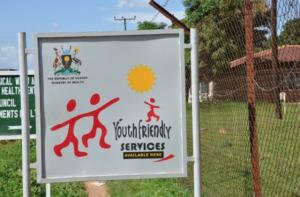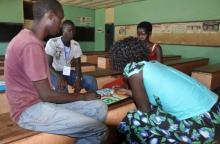Addressing Adolescent Health challenges in Uganda
Beatrice Awar (17) is typical Ugandan teenager, full of life, ambition and grand dreams about a comfortable future.
As she prepares the millet supper for the family one evening, Beatrice, who is in Senior 2 at Progress Academy, Abim Town Council in northern Uganda shares her dream.
“I want to be a nurse; God help me. I should know sciences and I should remain prayerful and protect myself from boys. I want to avoid early pregnancy and HIV” she says.
For many teenage girls in Uganda, realizing this dream can be a formidable challenge. Early school dropouts due to unwanted teenage pregnancies and marriages are a common occurrence.
According to the Ministry of Health, presently, 25% of the Ugandan teenagers become pregnant by the age of 19. About 49% are married before their 18th birthday and they start getting babies until their mid 40s.
Adolescents face a host of other sexual and reproductive health challenges. Complicated child births and abortions often requiring Emergency Obstetric Care are widespread. Sexually Transmitted Infections (STIs) including HIV infection are also common. Large families with poorly spaced children define a typical Ugandan rural community.
“Adolescents constitute the highest demographic segment in Uganda yet sexual and reproductive information and health services to meet their needs are still limited,” the Director General of Health services Dr Jane Ruth Aceng notes.
To try and overcome these limitations, the World Health Organization (WHO) Uganda Country Office with financial support from DFiD has since 2011 supported the MoH to strengthen the service delivery system in order to realise the sexual and reproductive health rights for the country’s rapidly growing young population.
WHO’s role
Through the UN Joint Programme on Population (JPP), WHO supported a number activities starting with development of adolescent friendly policies, strategies, standards as well as training manuals and job aides.
“WHO views this intervention as timely and necessary because young people aged 24 and below make up one third (69.3%) of the county’s population” explains Dr Wondimagegnehu Alemu, WHO Representative in Uganda.
Dr Alemu observes that for the intervention to succeed it is critical to “fully understand the needs, lifestyles, social and environmental determinants of adolescents in a manner that wins their trust and participation”.
Health workers trained
The MoH led the way, starting with a pilot phase in 15 largely rural districts. Health workers in those districts were equipped with professional skills necessary to work with young people. These include non-judgmental engagement and motivational approaches which go beyond merely providing information and preaching, to helping young people identify, own risks and devise protective measures.
The full training package offered health workers skills in; reproductive health (maternal, newborn and child health), family planning, Sexually Transmitted Infections (STIs) and HIV Counselling and Testing (HCT), male involvement and gender-based violence as well as Emergency Obstetric Care (EMOC).
“Before, my problem was how to handle the adolescents in a friendly way that encourages them to use health services. We were taught about teenage pregnancy, counselling, family planning, screening adolescents for STDs and HIV, and how to educate adolescents to keep busy so as to avoid risky behaviours. I’m now able to meet, listen to and counsel adolescents with ease”, says Annet Agaba, a clinical officer at Kanungu HCIV in the hard to reach and serve hilly Kanungu district.
Youth Friendly Corners rally young people
One of the highly applauded achievements of the JPP is the establishment of Youth Friendly Corners (YFCs) in selected health units where youths meet to play and also learn about health. The YFCs are equipped with infrastructure that appeals to young people such as video and TV screens, CD players and games such as ludo, pool tables, volleyball and football. In fact, YFCs are a response to the finding that youths shy away from seeking certain health services offered in open-to-all clinics for fear of being seen by parents or people who know them.
Agnes Atikuru from Aroi sub-county, Arua district is a Peer Educator in Aroi HCIII that receives between 50 and 70 young people each day in its YFC. She says that the training she underwent involved how to deal with abandoned adolescent youths and school dropouts counseling them to go back to school. She speaks with pride about a case she handled of one of the adolescents who got pregnant in 2009 while in S3.
Embarrassed and lost for options, she decided to stay at home even though she had been a promising student. But everything changed after counseling sessions with Agnes held in 2013. “I convinced her to go back to school. Her parents were able to pay school fees. As I talk now she is in S4 in Ombaci SS,” says Agnes.
The YFC have become places of a bee-hive activity in the communities. Youths continue to flock in everyday to watch educational videos; dialogue with peer educators and health workers on matters of sexual and reproductive health and development; play games and have fun too.
The YFCs and health clubs are also helping health workers to identify cases of teenage pregnancy, counsel the girls against criminal abortions and even engaging their parents to help them return to school after giving birth.
“YFC have enabled health workers to reach the primary target community of young Ugandans through peer educators who were supported under the programme. It is an excellent link between adolescents and health facilities,” says Dr Steven Ssebudde, the District Health Officer for Kanungu.
Community groups offer helping hand
With JPP support, youth-led groups that are a vital link in the Adolescent Friendly Health Services (AFHS) chain have been established in communities. They include the Male Action Groups (MAGs) and Alliance for Parents, Adolescents and Community for Adolescent Health (APADOC). These committees bring parents, adolescents, teachers and religious leaders together to deal with adolescent health problems as well as social economic activities.
David Adingga, 40, is a parent and a member of APADOC in Abim district; he believes APADOC will help deal with some of the difficulties that the youth regularly encounter. “I have seen parents responding positively and they are actively participating. The youths are also coming in positively because we have seen that most of the things we are talking about have been taking place in the communities.
Radio becomes a handy tool
There are also radio broadcast that are helping health workers disseminate health messages in the communities. With support from the JPP, District Health Educators and other health workers coordinating YFCs, MAGS and APADOCs regularly go on radio to sensitise the public and the youth in particular about AFHS.
Topics covered include; causes of bad parent-adolescent relationship, high school drop outs, teenage pregnancies and early marriage, dangers of unprotected sex, abortion and its consequences, defilement, and violence against sexual partners. Mr Charles Kavuma, the Mubende District Health Educator talks about a bi-weekly programme, Health Choices, that is broadcast on a local FM radio station (Heart FM) every Wednesday and Sunday that has tremendously supported AFHS initiatives in the district.
Data capturing tools
Another objective of the AFHS initiative was to facilitate capture of reliable and relevant data. The tools include the Activity Attendance List, Activity Programme List, Outreach Evaluation Form and Referral Form. The YFC and school health clubs were given data capturing tools to record information on variables such as the number of youths attending, the nature of their health needs and referrals made. The data captured will guide the review of the AFHS programme and enable the MoH appreciate the burden of disease linked to adolescents and what further interventions to introduce in health services delivery.
Early success
It is early to determine whether activities implemented under the JPP have had an impact on teenage pregnancy in Uganda. However, some excellent outputs have been noted. Simon Omeke, the District Health Officer for Katakwi, another remote district, talks about having been able to reach about 26,000 young people with reproductive health services and HIV/AIDS counselling and testing in 2012.
“We have also seen a number of young people especially those who are in the work sites like salons, restaurants etc increasingly accessing family planning services as a way of child spacing. When we look at our surgical operations in the theatre book register, we have fewer incidents of abortions probably because girls now have more information and access to contraceptives” he says.
This is a view shared by Mrs Josephine Katsya District Chairman for Kanungu,, who applauds the JPP for enabling community participation and for avoiding duplication of efforts. “The JPP has been good because of its collective effort approach to doing things” she notes.
Lessons Learnt
Four clear lessons emerge from the implementation of the JPP in Uganda so far:
• Scaling up the peer approach within the health facilities by having specially trained young health workers attend to youth helps win the trust of young people to seek health services.
• Locating YFCs at health facilities with facilities that attract the youth can help them get familiar with the facility environment and services offered and enable them to seek and access health services provided.
• Continued engagement of communities through community groups such as MAGs, APADOCs increases community awareness about the adolescent health needs and strengthens the delivery of services in communities.
• Modestly motivated peer educators help sustain continued provision of Adolescent Friendly Health Services to the youth.
These and more lessons if followed up and implemented throughout the country will help Beatrice Awar and other teenagers to lead a long, healthy and fulfilled life thereby assisting them realize their dreams.
_______________________________________________________









